
Hello folks, and welcome back to Into the Bronze Age! It’s an all-Super edition of our little project, featuring three different Super-centric titles! They are a very mixed bag of books, capturing the uneven, transitional nature of this part of the Bronze Age, all within the Superman Family. We’ve got some Silver Age-y silliness, along with some early bronze Age attempts at relevance. It’s quite the collection. So, without further ado, let’s see what Superman was up to this month!
If you’re new to this little journey, you can check out the first post to learn what it’s all about.
Roll Call
(You can see everything published this month HERE)
Action Comics #407Adventure Comics #413Batman #237Detective Comics #418The Flash #211Green Lantern/Green Arrow #87Justice League of America #95Mr. Miracle #5Phantom Strange #16- Superboy #180
- Superman #246 (#245 was all reprints)
- Superman’s Girlfriend, Lois Lane #117
- Superman’s Pal, Jimmy Olsen #144
- Teen Titans #36
- World’s Finest #208
Bolded entries are covered in this post, the others will be covered soon.
Superboy #180
Cover Artist: Curt Swan
“Prince of the Wolf-Pack!”
Writer: Bob Haney
Penciler: Bob Brown
Inker: Murphy Anderson
“Clark Kent, Madcap Millionaire!”
Writer: Leo Dorfman
Penciler: Bob Brown
Inker: Murphy Anderson
Yikes, guys. So, the Superboy title has often been a slog in my project, a source of goofy and senseless stories, more farce than fun, but this is one of the sillier, dumber yarns we’ve yet encountered, at least if you’re not counting Superbaby stories! I’ve been watching this ridiculous cover getting closer in my book list, and I’ve almost been dreading it. The central image seems to promise a good deal of silliness, and I can’t say that my trepidation wasn’t justified. To be fair, the goofy cover image is entirely accurate about what lies within. Now, the idea of Superboy displaying animalistic qualities isn’t necessarily a bad one, and there’s no real reason that it couldn’t have produced an interesting and exciting visual. The trouble is that Swan doesn’t really go far enough to sell the idea. Superboy is running with a pack of wolves, but he just looks like Superboy hunched over in a stupid-looking pose rather than something really strange and mysterious. It is much more out of place than it is intimidating. Yet, as dumb as the cover image is, the story inside is worse. I suppose that should come as no surprise, as it’s penned by that master of literary madness, Bob Haney, and in this story, he just about out-Haney’s himself.
It begins with an alien probe crashing on the Moon and releasing a strange radiation. Meanwhile, Pa Kent hears a wolf howling in the night outside their farm and rushes outside to kill it, noting that wolves haven’t been seen in those parts in years. Unbeknownst to elder Kent, a malevolent looking man named Adrian Lykan (because the story is about wolves, see?) is watching him and plotting his destruction….for reasons! The same evening, Superboy is walking alone, spending a whole two seconds in introspection and wrestling with an angst that is instantly forgotten, when he is transformed by the mysterious alien probe. Except…not really. It takes away his super powers and replaces them with…wolf…powers, I guess? He doesn’t turn into a Super-were-boy or anything. He just hunches over and looks silly, like on the cover. He also apparently gains the power to telepathically communicate with the pack of wolves which is conveniently hanging out nearby. They accept him as their leader and run through town.
And here it gets even dumber. The Mayor and the other Smallville-ites immediately turn on Superboy because he’s running with the wolves and set out to kill him. Yep. They flat-out decide to murder their former hero with Kryptonite bullets (man everyone had some of that stuff back in the day), just because he’s acting strangely. Don’t bother to investigate or help the kid. Nope, just shoot him in the face. Well, while the terrible townsfolk gather the pitchforks and torches, Lykan sets his plan in motion. The evil man, who apparently likes being evil because he’s all evil and such, has decided to destroy the “most moral citizen” in Smallville, and that’s apparently Kent. Why does he want to do this? What does he hope to gain? Well, this is Zaney Haney, and he has no time for “logic” or “motivations”!
How does Lykan plan to destroy Kent? Is he going to use his magic powers to curse the upright man? Mind control him? Take his shape and frame him? No, don’t be silly. Instead, and try to follow me here, he poses as a contractor, gets Kent, as town treasurer, to hire him for a job, gets paid in cash by Kent who is in a hurry to help his son, fakes work papers for illegal Mexican laborers, brings them in to do the job, and then poses as someone else in an attempt to blackmail Kent about the whole business, setting him up as a patsy. Did you follow all that? If not, don’t worry; I’m sure you’re not alone, as it doesn’t make a whole lot of sense. And I haven’t even gotten to the mystical wolf-guardians yet. Hang on to your cape!
So, as Lykan’s plot is unfolding, the townsfolk hunt Superwolf and his pack and straight-up shoot the kid with a Kryptonite bullet. Fortunately, one of the Mexican workers saves him and takes out the bullet, and because he has lost his powers, the alien mineral doesn’t affect him. Lucky break, that. While he recovers, Pa Kent goes to get the unwittingly illegal immigrants and sets out to hide them away until he can sort things out. On the way, however, Lykan uses his magic to hijack the truck and drive it off a bridge, only for the workers to be rescued by the werewolf-wonder’s wolves. Who knew that one of a wolf’s abilities was super-swimming!

Meanwhile, Chief Parker arrests Kent because of the frame job against him, and the town brings in a wolf hunter who is actually Lykan in disguise…for reasons? He tracks and attacks Superboy, using magic AND a gun, which just seems like overkill, shooting the kid a second time! This is an unusually violent issue! The Lupine Marvel holds him off until his pack arrives and chases the warlock away. Just as Clark is about to die, the alien probe that conveniently gave him wolf powers even more conveniently shuts off, restoring his powers and saving his life. The pack slink off into the night, and we’re told that wolves, far from causing evil, apparently are secretly holy beings that show up to combat evil when it appears….somehow….for….reasons.
As Lady Grey said when I described this tangled mess of a tale, “Well, that certainly is a story…” That’s really about all you can say for it. It’s so silly, unnecessarily convoluted, and poorly developed that it almost defies description. It is a pretty perfect example of the negative side of Zaney Haney’s excesses. Yes, it is full of creative ideas and rapid-fire invention, but all of these new elements are lacking any sense of purpose or significance. We get a bizarre marriage of magic and science between the wolves, warlocks and rogue satellites, and it all moves at the speed of plot, with no effort to make any of it make sense. It’s just weird, silly, and unsatisfying. There’s nothing that justifies this story being a Superboy story, as even his powerset is swapped out for whatever the heck Haney wanted. You could plug almost any other character in here, and it would make as much (or as little) sense. The art is fine throughout, though Brown’s portrayal of Superwolf is just goofy looking. It would even have been more effective for him to have actually physically transformed. That also could have helped justify the townspeople’s insane reaction to his change. I’ll give this bizarre yarn a single sad Minuteman, as it really has nothing to recommend it, lacking even the exuberant fun of many of Haney’s crazy stories.
P.S.: Interestingly, the letters column includes a fascinating and mysterious missive (bottom of left column), in which the writer complains about Superboy’s excessive happiness and lack of angst and suggests the addition of a supporting character with some horrific type of hang-up, the details of which the editors refuse to print, citing the Comics Code. One can’t help but wonder what kind of tragic issue or scandalous story was suggested. Notably, the editor’s reply offers an argument that I generally find quite compelling, citing the need for escapism and joy in comics. Given the nature of this cover story, however, I find myself wishing that such efforts would nonetheless acquire a bit more quality and craftsmanship, in addition to their search for the strange and whimsical!
“Clark Kent: Madcap Millionaire”
Our backup tale is not as dumb as the headliner, but it is still rather silly and very Silver Age-y. This story revolves around an almost unknown relative of the Kents, a rich uncle (doesn’t everyone have one?), who I thought had been conjured ex nihilo in the style of Bob Haney. Yet, this random guy has actually shown up exactly one other time that I can discover, in Superboy #119. According to the DC Database, he will have one more appearance, in Superman Family #191, years later. At any rate, this Kendall is fabulously wealthy, but he has no children, and he is trying to bribe Clark to into letting him adopt the extraterrestrial orphan. After all, that is clearly the only logical solution to his situation. Heaven forbid he, I don’t know, adopt any other kid who needs a family.
Well, despite the fact that the Kents are sure that Clark won’t pay any attention to the wealth Kendall can give him, the young man suddenly becomes very enthusiastic and jumps into a fancy sports car….which he then proceeds to crash directly into a wall. Surviving the fiery explosion uninjured somehow doesn’t give away his secret identity, and the rather battered Boy of Steel turns on his parents and accepts his uncle’s offer. What is this? Superboy acting out of character? Yep, you guessed it, this story is a prime example of Superdickery, and as usual, an unjustified and silly one at that.
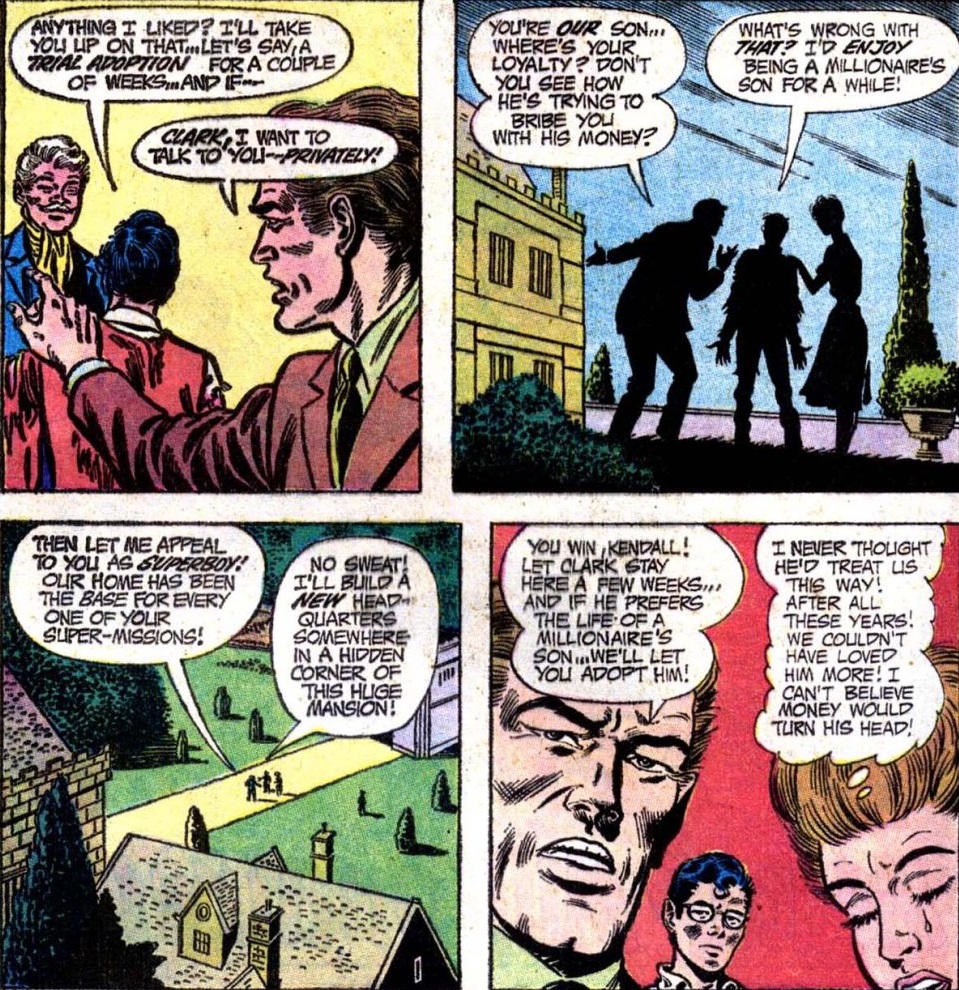
Clark gets up to various other antics, but it doesn’t take us long to discover his reasons for acting like a spoiled rich kid. While scuba diving in his uncle’s private lake, he rips open the old man’s raft, sending him careening to the shore, and then blows up the dam with his oxygen tank (which seems unlikely, even by comic logic). It turns out that the raft was full of poison gas, and if his uncle had fallen in when it deflated, he would have died. Uncle Kendall’s lawyer, Larry Frane, is the only other character we meet, and he tries to convince the old man not to adopt Clark. Gee, I wonder who the villain of the piece could be? Yep, the lawyer is essentially Checkov’s Mouthpiece.
It all comes to a head when Clark sees the lawyer plotting another deathtrap for Kendall, this one involving a strategically weakened railroad trestle. The Boy of Tomorrow swoops in and catches the larcenous lawyer in a trap of his own devising in a scene that looks for all the world like he is crushing the poor guy to death. Look at the terror on Frane’s face! After dealing with the death-threat, the Smallville Superhero confesses to his parents that he had discovered Frane’s fiendishness on that first day and had wrecked the car because it had a bomb in it. He pretended to be a spoiled brat to protect his uncle…because that was the only way. Sure. Let’s not forget that he kept up this charade when he spoke to his parents in private. So, essentially, our hero emotionally tortured his parents for no good reason. Yay?

This is a fairly silly story, featuring a mostly unprecedented rich relative who is just a plot device, and a ‘barely there’ premise so thin you can just about see through it. This type of story is not my favorite at the best of times, but this particular example annoys me because it doesn’t make much effort to justify itself. Nobody has any personality or development, and our hero’s actions aren’t really justified. The art is quite good throughout, but it can’t save a sub-par story. I’ll give this one 2 Minutemen. It’s weak, but not as weird and wacky as our headliner.
Superman #246
Cover Artists: Curt SwanMurphy Anderson
“Danger–Monster At Work!”
Writer: Len Wein
Penciler: Curt Swan
Inker: Murphy Anderson
Editor: Julius Schwartz
The Fabulous World of Krypton: “Marriage, Kryptonian Style!”
Writer: Cary Bates
Penciler: Rich Buckler
Inker: Murphy Anderson
Editor: Julius Schwartz
“There Is No Superman!”
Writer: Jerry Siegel
Inker: Stan Kaye
Editors: Whitney Ellsworth, Jack Schiff, Mort Weisinger, and Julius Schwartz
Well, if our Superboy issue was a disappointment, our flagship title might help make it up to us. Len Wein gives us an adventure that makes sense and has at least a little logical consistency, unlike our first two tales. Interestingly, although we have a classic example of a Superdickery cover here, the tale within is nothing of the sort. It’s a classic bait and switch, with our hero being a complete jerk on our cover in a fashion that has only the slenderest connection to his actual actions. The cover itself is solid enough, though not too much more than that. The blob-like monster’s destructive rampage is well-depicted, and Superman’s inexplicable disinterest could intrigue readers. The contrast makes for an odd and entertaining tableau.
Our actual headline tale begins in the middle of a thunderstorm, as our titular Superman dives deep down into the Marianas Trench in a rather nice sequence. He has come to collect samples of algae and plankton, and after a clam-related calamity, he resurfaces in time to lend aid to a ship swamped by the storm. In a fun little moment, a somewhat chagrined Superman berates himself for letting the clam catch him, thinking “Aquaman would never let himself get trapped by a giant clam!” I found that a charming touch, and it’s nice to see Clark being a bit more introspective and fallible in this small way.
Back on the surface, it turns out that the Man of Tomorrow was gathering the samples for the minds of tomorrow. That’s right, this is the first appearance of the organization that was fast to become a fixture of the DCU, S.T.A.R. Labs! That’s fun, and I’ve been wondering when it would show up. Interestingly, it isn’t given much fanfare or attention, just being used as a bit of set-dressing. I’m curious how long it will take before this perennial source of heroic support and mad-science threats will become ubiquitous in the pages of DC Comics.
Whatever lies in its future, at the moment S.T.A.R. has sent Superman to fetch samples from the depths of the ocean in the hopes that they will be the key to designing an organic pollution solution, an engineered algae that will assess corrupt matter and clean it automatically. Surely that could never go catastrophically wrong, right? Well, after dropping off the samples, the Metropolis Marvel returns home, and Wein gives us a lot of little character moments throughout these opening pages, providing more characterization and personality in 5 pages than we got in the entirety of our previous comic. As part of that, we get a charming moment where Clark drops in to check on his elderly, ailing neighbor. His doing so also opens the door to a rather odd subplot in the story, as he hears about a group of his neighbors who are arming themselves and forming a vigilante committee because the streets have become dangerous. Mr. Mild Mannered makes the case that they shouldn’t take the law into their own hands, which is deeply ironic considering what he does in his free time. If you’re wondering what this has to do with deep-sea algae, well, you’re not alone.

Speaking of Superman’s samples, back at the lab, a scientist makes a breakthrough in his experiments with it but accidentally drops several beakers into the sink, sending the mad-science mixture into the sewers! Later on, the Man of Steel goes for a patrol in the still-raging storm, and we get a very interesting panel in the style of Kirby’s experiments with combining photos and drawings, as our hero flies through a city-scape. I think this is more successful than most I’ve seen, as Swan and Anderson manage to merge the two images a bit more effectively than is usually the case. During his patrol, the Last Son of Krypton discovers a strange gelatinous monster rise from the sewer and threaten civilians, but when he pursues it, he discovers that it is actually cleaning the sewers as it goes! Thinking that this thing could do the city some good, he decides to just try to drive it through the sewers before disposing of it. It works like a charm, for a little while, and then the green growth suddenly explodes into the street and begins to devour all in its path, not just pollution!

Superman finds this creature to be a difficult foe, as he can’t seem to hurt it, despite his great strength, and it constantly oozes out of his grip. Finally, he strikes upon an idea and creates a whirlwind to suck the ooze into the ozonosphere, where he reasons the oxygen-rich environment will weaken it, as “no organism alive can survive in the poisons of its own waste products,” and since this creature gives off oxygen, oxygen should presumably be the one thing it can’t process. The Man of Steel’s skyward gambit pays off, and the creature is weakened enough for him to bind it in plastic and return it to S.T.A.R. Labs for study (I’m sure they’ll keep it safe and definitely not endanger the city with their further experiments…). Oddly, the story ends, not with our hero’s success, but with his return to his apartment, where the gun-toting yahoos we met earlier have managed to accidentally shoot an innocent bystander. Superman speeds his wounded neighbor to the hospital and says “I told you so” to a now chastened group of vigilantes who, for some reason, aren’t being arrested for shooting someone!
This is really a solid story, not exceptional or earth-shattering, but a good, entertaining yarn that presents our hero with an interesting challenge and manages to provide a bit of characterization and some fun moments along the way. Wein provides a logic for everything that happens, and it all feels like a good Superman adventure, with the hero faced with an opponent he can’t merely overpower. Wein comes up with a clever solution to this problem, and even better, the solution makes sense, in a comic-science kind of way. The little touches, like the episode with the clam, or a moment where the blob steals a smoker’s cigarette are fun and help to make this tale more than just a standard monster-mash. The only real flaw is the completely unconnected subplot about armed vigilantes. It receives almost no attention and has absolutely no impact on the main plot, making it feel out of place. The art, for its part, is quite good throughout, with Swan and Anderson doing a really nice job with the somewhat dim, rainy setting that is found throughout the story. It gives this tale an unusually moody, atmospheric feel for a Superman yarn. Overall, this is a fine, fun comic, and worth an above average 4 Minutemen. It’s a pleasant relief from the silly stories of our first book in this batch.
“Marriage, Kryptonian Style”
Once again, the World of Krypton backup proves to be an interesting and entertaining slice of sci-fi to complement our feature story. This issue’s offering is rather intriguing, considering how the interpretation of Krypton will change in coming years. It is all about a rather surprisingly dystopian concept for the pre-Crisis version of Krypton, a massive computer, Matricomp, that controls who can marry who. It isn’t quite as dark as such concepts usually are these days, as people are not normally paired together arbitrarily or without their consent. Instead, they form their own relationships and merely come to the computer to see if they are compatible for marriage. It is such a journey that young Jor-El and Lara Lor-Van undertake, but when they present themselves to the machine, it does not give them an immediate answer, which is unusual. Jor remains sanguine, but Lara is worried, and as it turns out, rightfully so!

The next day, she is approached by an attendant from the computer complex named Anr-Mu (and I can’t wrap my head around how to pronounce that!), who informs her that the device found her and Jor-El incompatible and their marriage has been forbidden. She refuses to give up and goes to question the computer, only for Matricomp to tell her that the only man on the planet with whom she is compatible is Anr. What a coincidence! Clearly nothing nefarious going on here! Lara doesn’t take kindly to being paired up with a stranger, but Anr tries to hypnotize her, only to be interrupted by the timely intervention of Jor-El. However, the fighting scientist’s attack is easily shrugged off, and Anr takes a pacified Lara away.
Fortunately, though Jor may lack his future-son’s super strength, he’s still a very smart guy, and he manages to solve the mystery behind these strange events. He confronts Matricomp with the revelation that the computer is actually the cause of his troubles. Apparently, the great machine, being wholly devoted to shepherding love, has become enamored with the idea of love itself. It created an android, Anr-Mu, and through him sought to experience love for itself. After handily explaining its plot, the corrupted computer tries to crispy-fry its challenger with an electrical burst. Yet once again the great scientist proves his brilliance, having worn rubber clothing that protects him from the zap. Thwarted, Matricomp commits synthetic suicide, blowing itself up, but Jor manages to escape and reunite with Lara, free to create their own destiny.
This is a good little backup tale, with an interesting premise that is a curious glimpse of a more dystopian version of Krypton, something similar to the sterile, dehumanized world that John Byrne would conjure in the next decade. Bates delivers a quick but complete adventure in these 8 pages, with an intriguing addition to the mythos. I have rather enjoyed these tales that feature a two-fisted version of Jor-El. It reminds me of the glimpses we get of the more heroic version of the character from Superman: TAS. I’ll give this solid backup a strong 4 Minutemen.
Superman’s Girlfriend, Lois Lane
“S.O.S. – from Tomorrow!”
Writer: Robert Kanigher
Penciler: Werner Roth
Inker: Vince Colletta
Editor: E. Nelson Bridwell
Lady Danger: “The Needle in the Haystack!”
Penciler: Carmine Infantino
Inker: Carmine Infantino
Rose and the Thorn: “The Ghost with Two Faces!”
Writer: Robert Kanigher
Penciler: Rich Buckler
Inker: Dick Giordano
Love must be in the air…along with mind control. This month we learned about marriage, “Kryptonian Style,” and we also get an issue of Lois Lane where the relationship between Superman and our headlining heroine is a bit more developed and overt than we usually see. More importantly, it’s a story with an intriguing premise and setting that doesn’t quite live up to its potential, once again displaying Kanigher’s active imagination and somewhat uneven writing. However, if the tale itself isn’t everything it could be, the cover is pretty spectacular. Roth delivers a really striking image, inviting us into the disorientation of our stars as they stare at a world “turned upside-down!” It’s a nice piece, and Roth has added a lot of detail to the topsy-turvy terrain, as well as two of his traditional beautifully drawn figures. It’s a great piece and very effective. Unfortunately, it’s rather more exciting than the story it heralds.
The actual adventure begins with some unseen figure sending a message in a bottle, only for it to be struck by lightning and hurled through time! That’s an intriguing opening, but back in the ‘present,’ Morgan Edge is chewing out his two top reporters, Clark Kent and Lois Lane, because it is a slow news day, which I’m sure makes for just dynamite leadership. Interestingly, once they leave he opens a secret screen on his desk and gazes at…himself! The multiple Morgan mystery remains, but it won’t be solved this issue. Meanwhile, Lois hits the town trying to find a story, but everything is quite, other than the silent struggle of the drug epidemic and its cost, but as a cynical doctor says, that is hardly front page material at this point. With nothing newsworthy happening, Superman drops in to take Lois out on a date, and they share a romantic afternoon, which is a little strange to me, as I’m more used to a Superman who keeps Lois a bit more at arm’s length, but this is the same era that gave us that bonkers book with Superman having a family dinner with his wife and son while in full costume. Anyway, during the date, Lois finds our time-traveling letter in a bottle, and it is an S.O.S. from 2196…the future!
The pair decide to investigate this mysterious missive, and they travel to a future divided between two classes, the “Upmen” and the “Downmen”. Apparently the “Upmen” seized control of the world through “tle,” a powerful drug that keeps the lower class subservient and docile. Those who refuse to be drugged are hunted down like dogs, and it is in the middle of such a hunt that our heroes arrive. The Man of Steel easily protects a group of the down-trodden Downmen from their upper-class oppressors, but once the powers that be see his strength, they offer a truce and a tour of their world. The time-tossed twosome are treated to a feast, only to be drugged with tle. In a welcome if not entirely effective sop to logic, we’re told that this drug is alien in origin, and Superman theorizes that it must have originated on a planet with a red sun, explaining its ability to affect him. I can accept an alien drug affecting him, but the plant coming originally from a world with a red sun makes no real sense, of course. It’s not like the current crop has “red sun radiation” in it or anything.
Dubious story logic aside, our drugged protagonists then face a rather odd adventure. They are made pliant by tle and sent to hunt the Downmen hiding in the woods, with an objective set for a tower on the other side of the forest, but they just sort of wander through the undergrowth on a high for a while. Then the substance wears off, and they face terrible withdrawals, including bizarre hallucinations. Finally, they reach the tower, and Lois refuses to stay behind, which is brave and all, but a little silly considering that we’re talking about Superman. What exactly does she think she’s going to contribute to this little assault?

The tower defenders shoot them with gas which messes with their equilibrium, as we saw on the cover, but seeing as the Metropolis Marvel regularly flies around the world, this isn’t really all that effective. With a rather odd looking kick, the literal Man of Tomorrow smashes the tower and captures the Upmen, finally leading their downtrodden slaves in burning the tle fields before returning home.
So, I’m guessing this is Kanigher’s attempt at an anti-drug story, following in the footsteps of O’Neil’s recent groundbreaking Green Arrow/Green Lantern yarn. It’s less focused and less successful, though the depiction of withdrawal symptoms is interesting, and it is certainly unusual for Superman, of all characters, to be the one depicted as strung-out. The central anti-drug message is obscured by the trappings of the future setting, including the fact that the drug is mandatory rather than being a temptation. The plot is also a bit confusing and contradictory, with our heroes being drugged and sent to hunt the Downmen, only to just sort of wander about, with the tower made their objective, but also being forbidden….it’s odd and doesn’t quite make sense. What exactly is the Upmen’s plan here? It’s still an enjoyable story, with some nice action beats that work better than some of Roth’s earlier efforts. In general, his art is excellent throughout. As odd as it is to see the Man of freaking Steel paddling a canoe in the park, Roth really does great work with the romance elements of his stories. Yet, his portrayal of the withdrawal scene works okay too, though the melodrama is turned up to 11. In the end, this is an odd, uneven, and rather poorly thought-out offering on the drug question, though it isn’t a bad read. I’ll give it 2.5 Minutemen, as the adventure is serviceable, even if the themes don’t get developed properly.
The Ghost with Two Faces
As has often been the case, our Rose and Thorn backup blows the headliner away, delivering a good, solid adventure story with some neat touches. It begins with the clueless young Rose watching footage of her alter-ego, the Thorn, taking out some bank robbers in a really cool sequence that actually makes it look believable that this lovely lady could take out an entire group of lethal gunsels. That night, Rose dreams of a strange house, inside of which lies a mystery she must solve. When she leaves for vacation the next day, she actually discovers the house from her dreams and rents it, even though it is supposedly haunted. In a clever touch, the girl receives a Thorn costume in the mail and is confused by it, though readers realize it clearly must have been sent by her other personality, as her innocent side obviously wouldn’t have packed it for her vacation. I like that attention to detail.
By day Rose bathes on the lonely beach by her rented house, but by night, the Baleful Beauty takes over, and she stalks the sands, searching for a kidnapped newspaper publisher and his wife. Although a night-traveling naturalist manages to snap a photo of her, the Nymph of Night runs her quarry to ground, and in another really nice sequence, she takes out the kidnap gang and frees their prisoners. The next day, Rose is startled to discover that the “ghost” of the house has been captured on camera, and it is none other than the Vixen of Vengeance herself, the Thorn!

This is a fun, fast-paced tale, with a surprising amount of personality packed into its few pages. The story clearly doesn’t take long to summarize, and yet it was a good read. My only complaint is that the dream about the house is a bit ambiguous. Are we supposed to understand that the Thorn was already working on the case, and she wanted Rose to use the house as a base? It doesn’t actually play any role in the plot, other than putting her in the vicinity of the kidnappers. We also don’t really get time to develop any of the story’s elements very much, but Kanigher keeps the plot simple enough that it doesn’t need too much more space. Nonetheless, this action-packed adventure made for an enjoyable yarn. This month we’ve got Rich Buckler taking over the art chores, but Dick Giordano is still inking, and the pair of them make for a heck of a team. The art is gorgeous and atmospheric, really nicely suited to the character. The action looks particularly good, and Buckler’s layouts are really dynamic. I know Buckler mostly from his work on Fantastic Four, which is good, but I think the work he does here is even better. Interestingly, though he did both this and the Krypton story from this month, they look pretty different. I guess that’s the impact an inker can have, and I think Anderson is often rather heavy-handed, to create more continuity with Swan’s work. Whatever the case with the art anomalies, I’ll give this fun romp a solid 4 Minutemen.
Well, that does it for our Super-story-extravaganza! And a very mixed bag of Kryptonian hi jinks it was. We had some solid yarns and some intensely silly ones, featuring social issues from pollution to drugs. Nonetheless, I had a good time reading them, especially given the darkness of the day. I hope that my coverage of these comics has been a pleasant diversion for y’all, dear readers! I also hope that you’ll join me again soon (hopefully!), when we’ll finish up this month and continue our journey Into the Bronze Age! Until then, keep the Heroic Ideal alive!


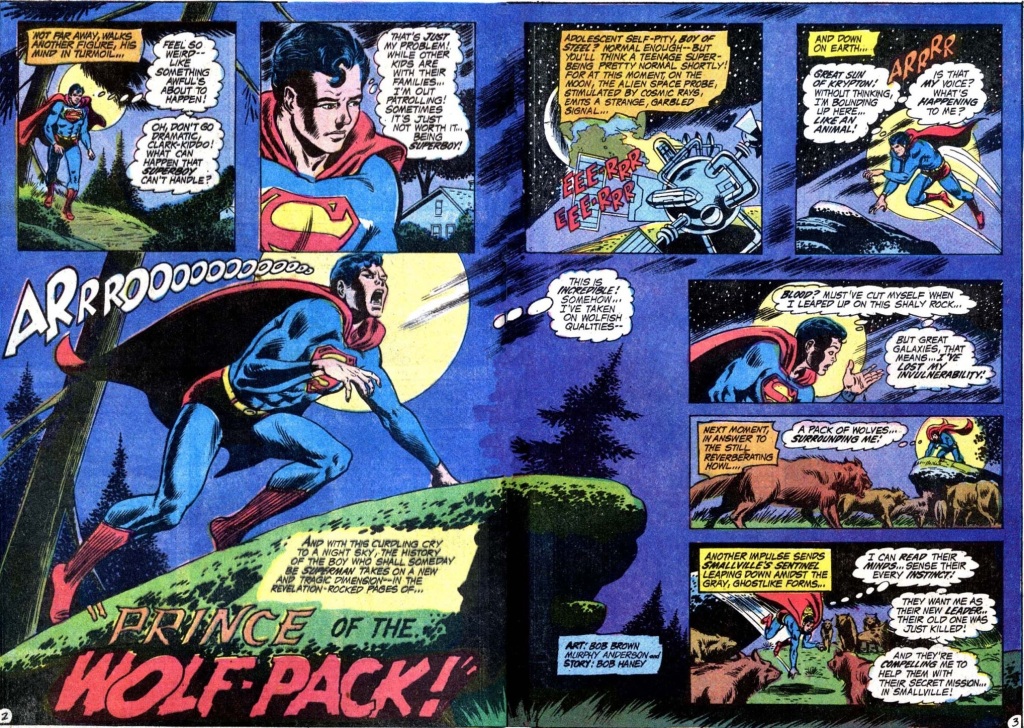


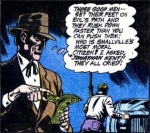








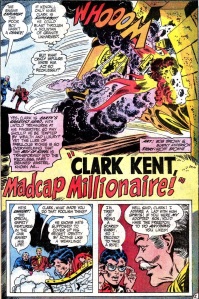




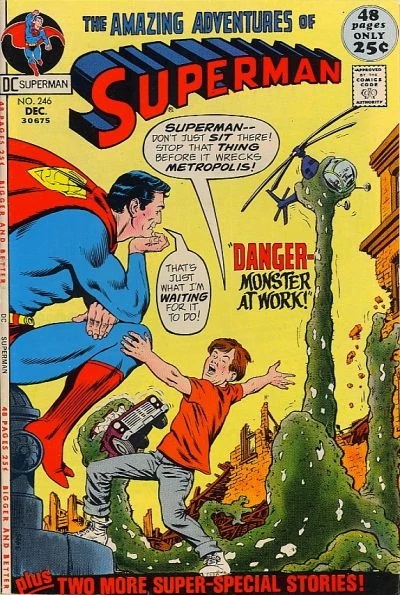



































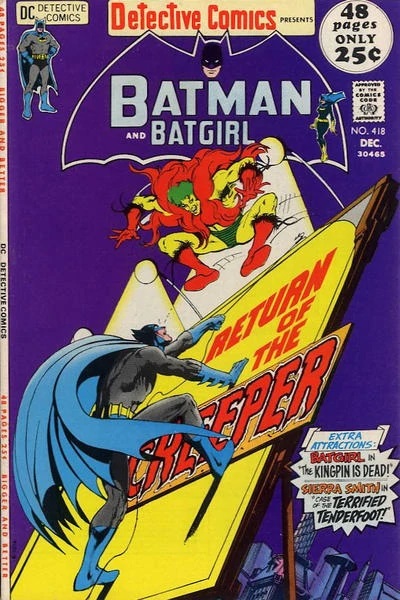





















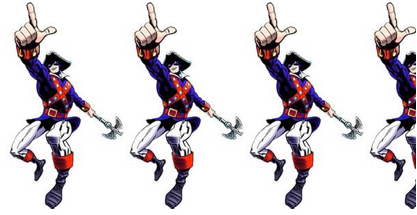


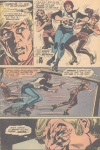






















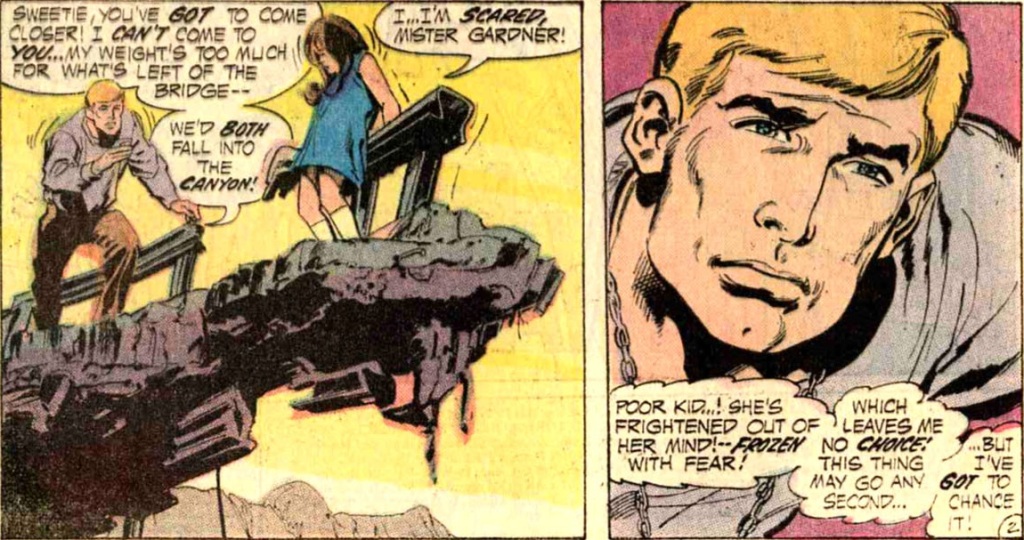













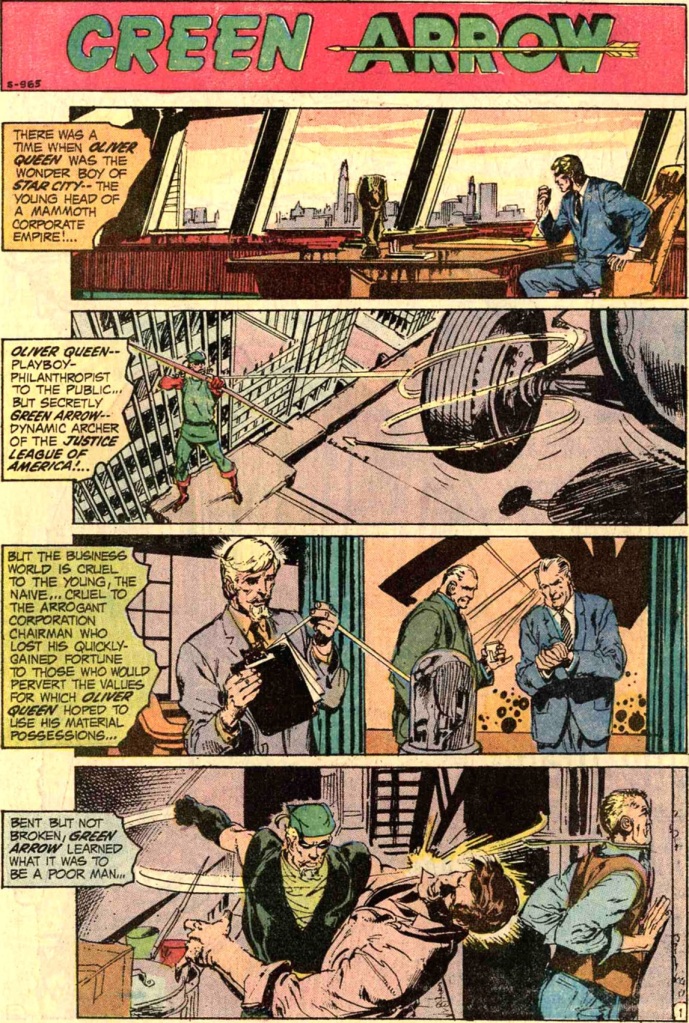

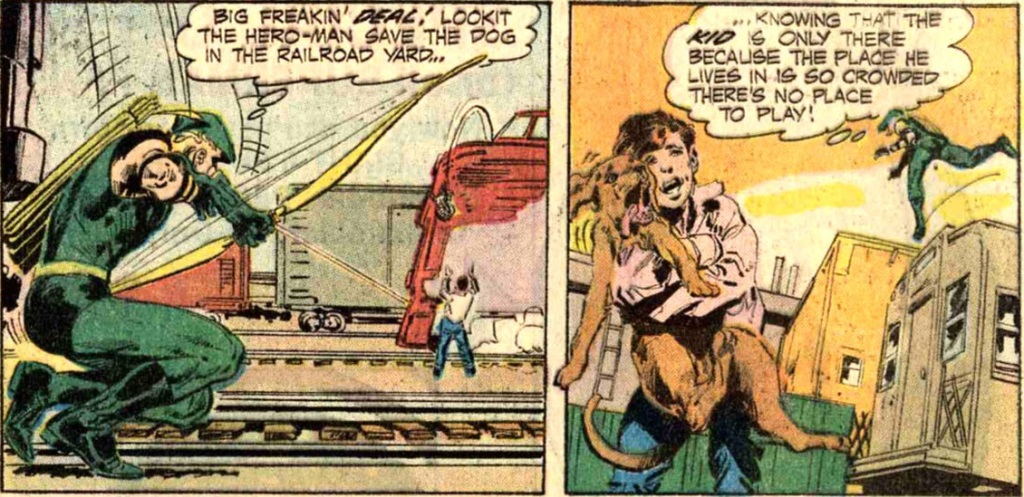








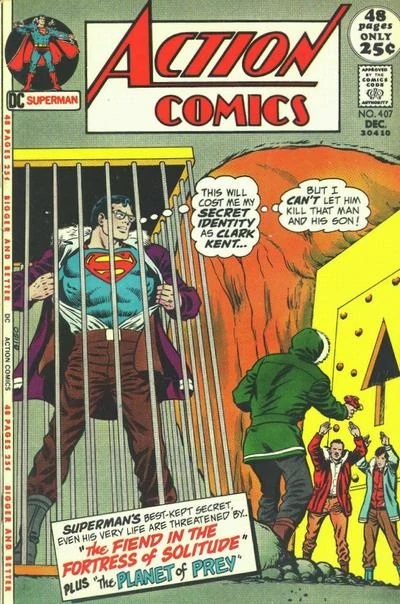

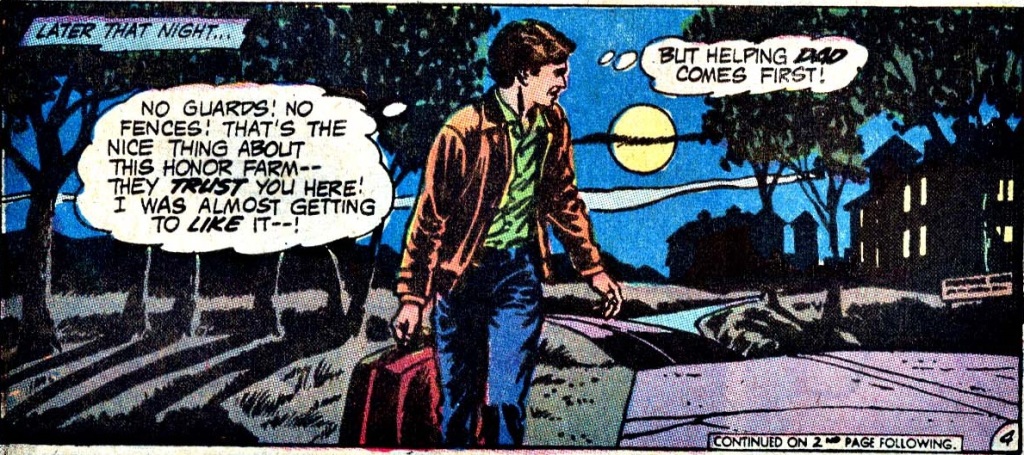
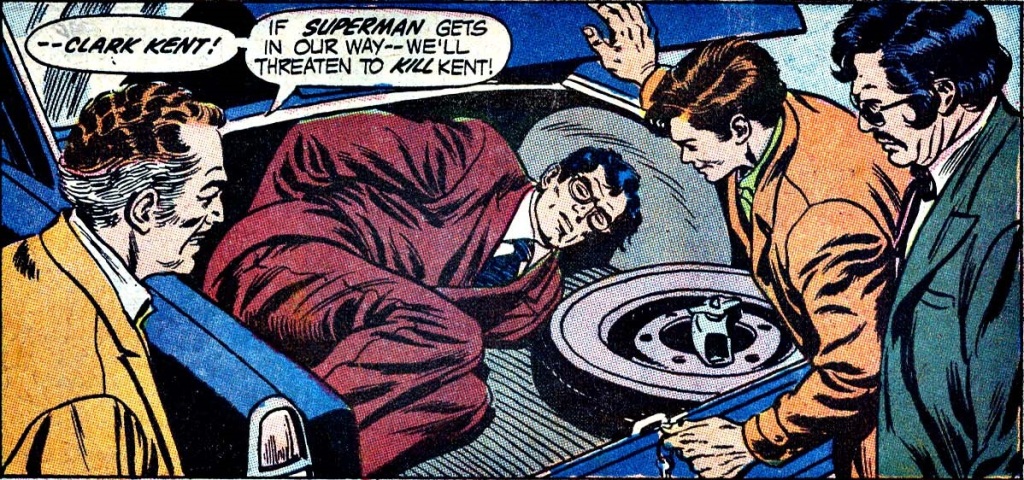





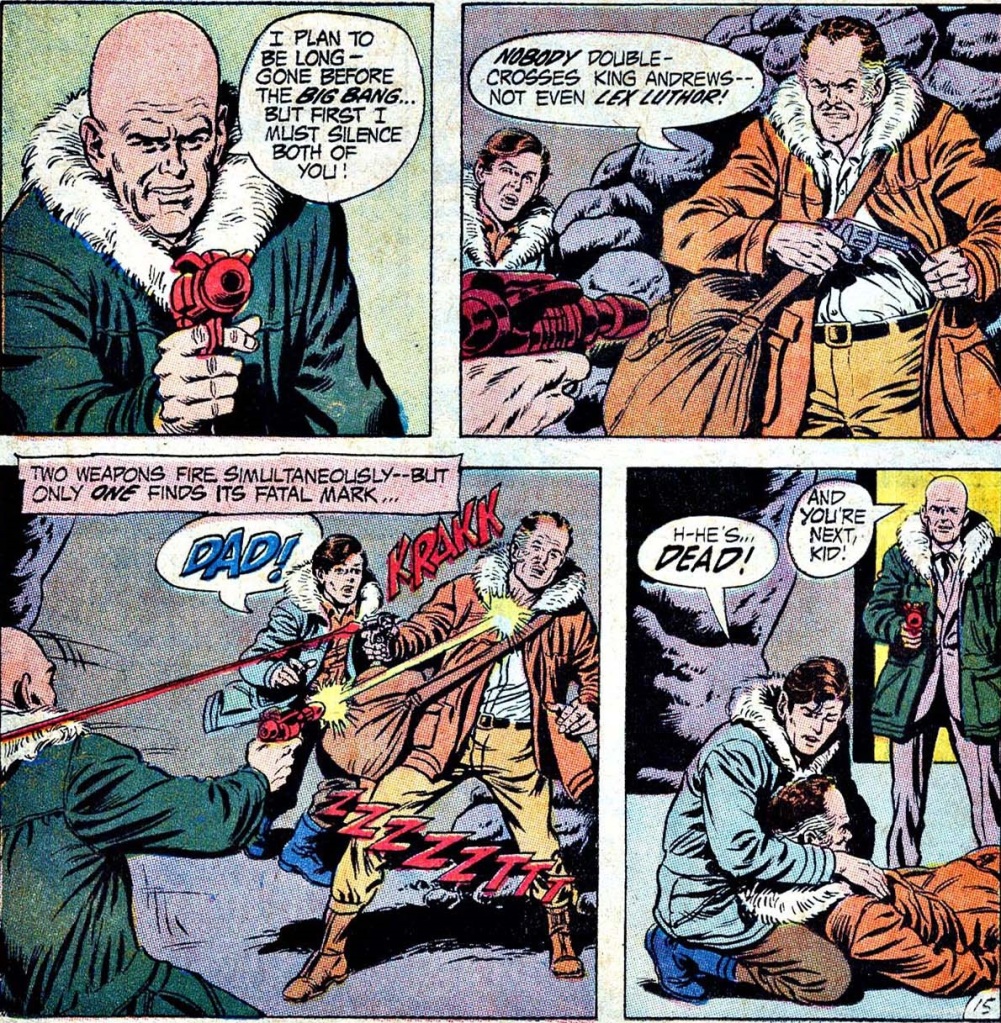
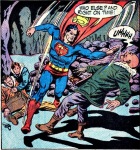


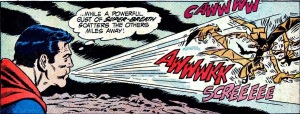
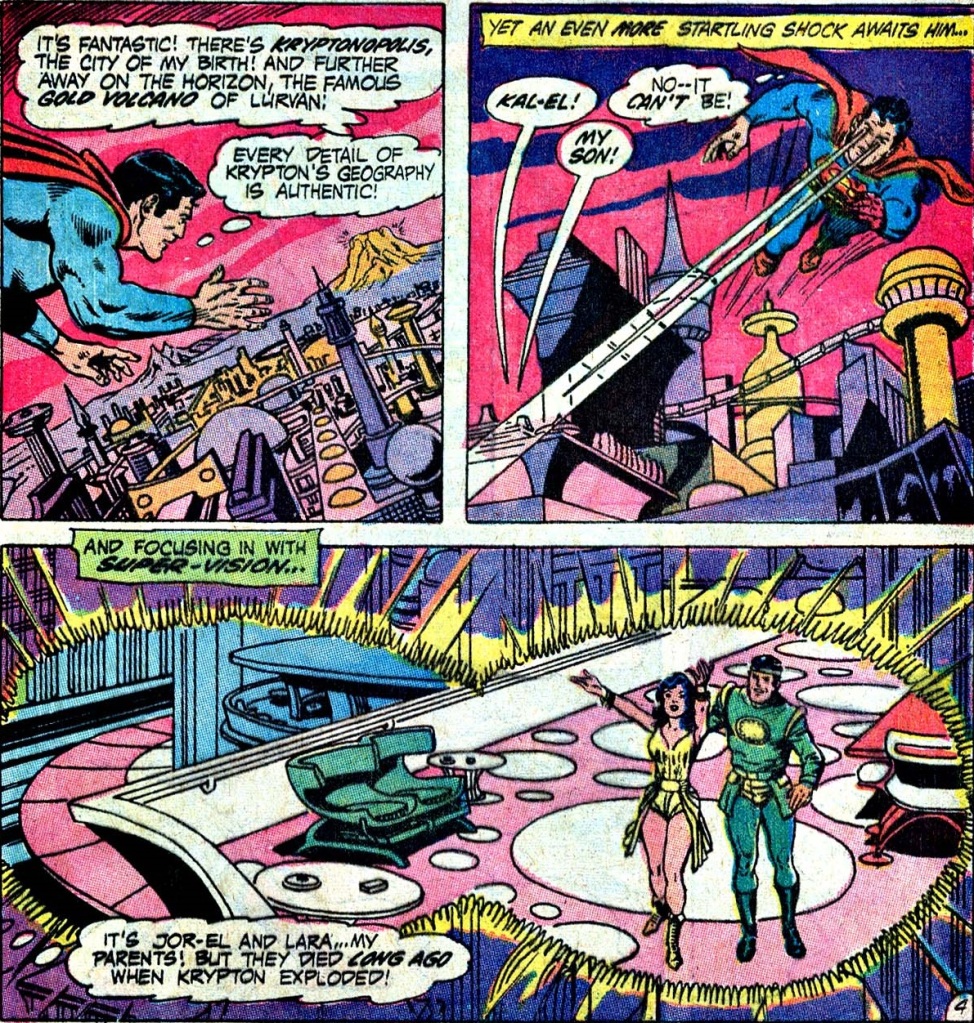
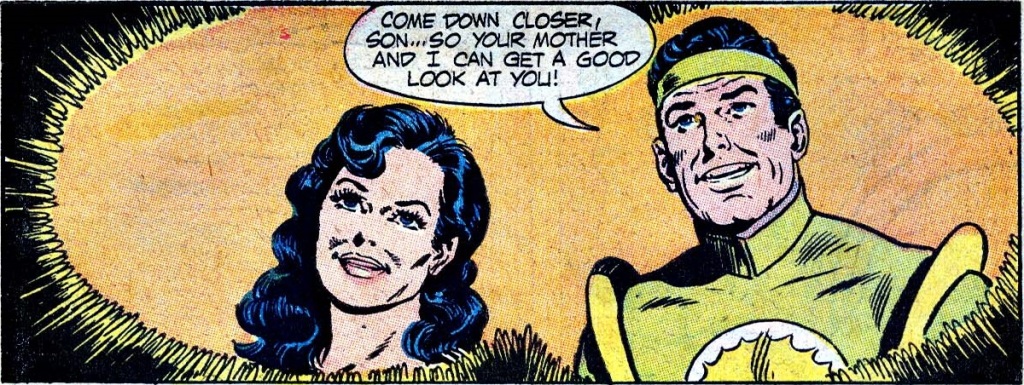



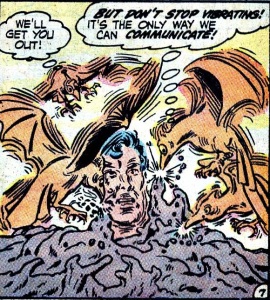

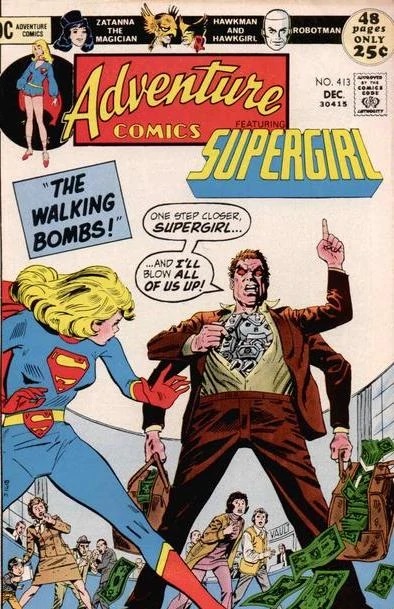
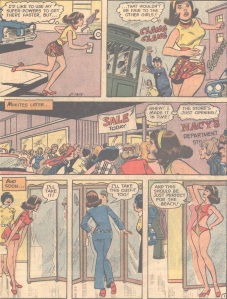
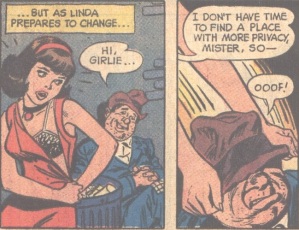




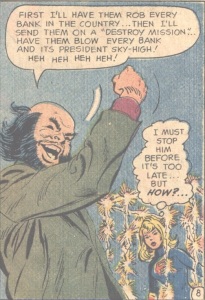




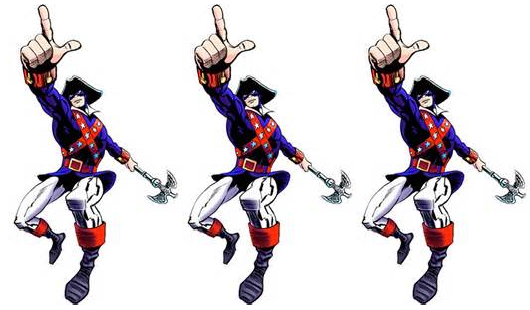
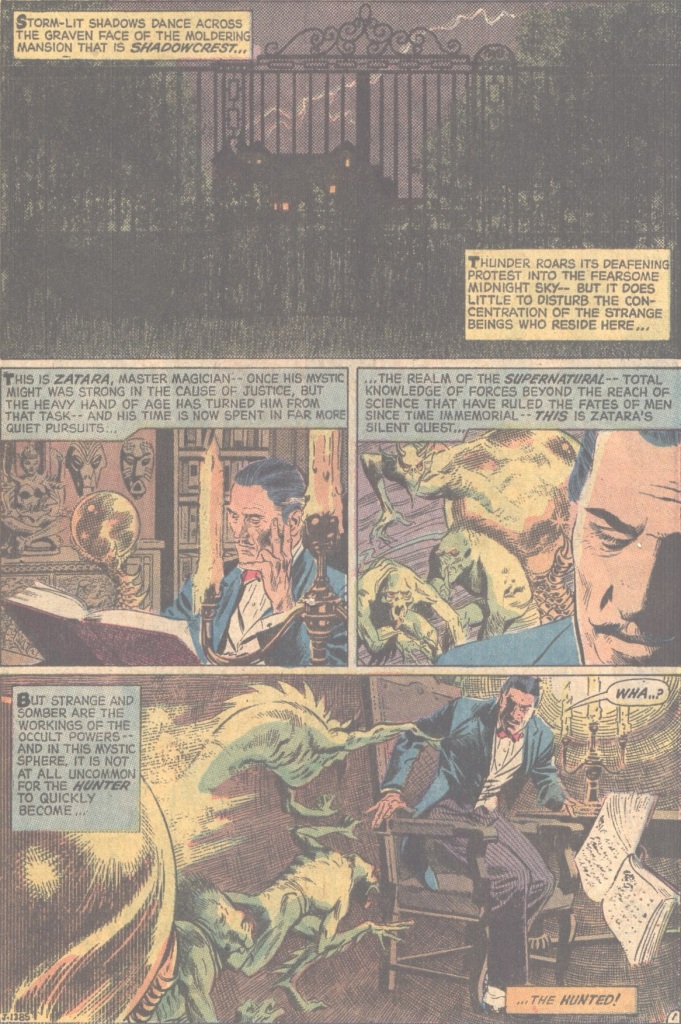
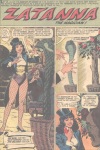



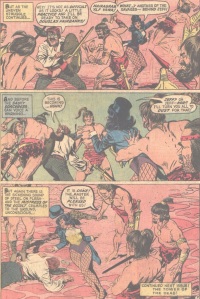
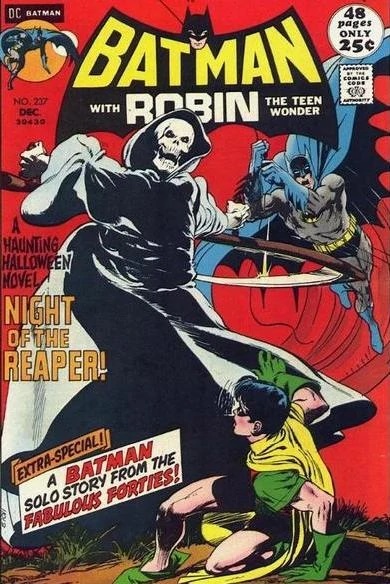
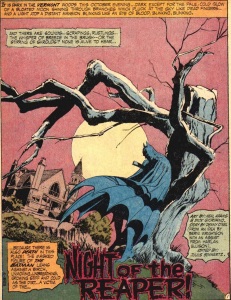


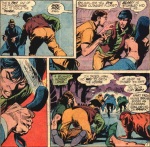







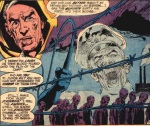
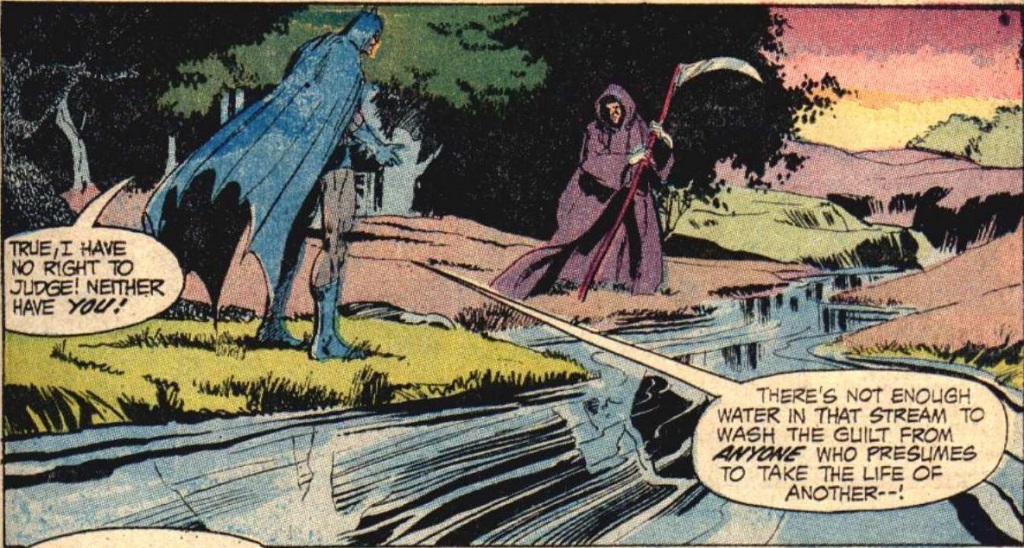


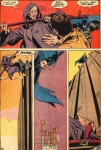

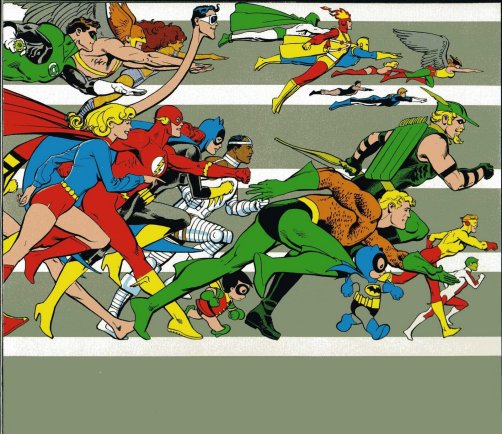











































 Though the immediate threat is dealt with, apparently Dave Stevens has gone missing, and Superman takes the ladies in search of their friend. While looking, the Metropolis Marvel sees a drug dealer offering his wares to some kids, so he uses his heat-vision to burn the drugs out of the guy’s hands! It’s a crazy and rather funny little moment, but we aren’t given long to enjoy it as our hero is immediately attacked by a motorcycle gang known as “The Devil’s Deputies,” who are totally not the Hell’s Angels! These apparently suicidal bikers try to take out Superman…the Man of Steel…with chains….yep, just regular chains. We get some dialog about how they think his powers are still on the wane, but still! What follows is a bit more rather awkward-looking action as the Metropolis Marvel blows their chains back around his antagonists.
Though the immediate threat is dealt with, apparently Dave Stevens has gone missing, and Superman takes the ladies in search of their friend. While looking, the Metropolis Marvel sees a drug dealer offering his wares to some kids, so he uses his heat-vision to burn the drugs out of the guy’s hands! It’s a crazy and rather funny little moment, but we aren’t given long to enjoy it as our hero is immediately attacked by a motorcycle gang known as “The Devil’s Deputies,” who are totally not the Hell’s Angels! These apparently suicidal bikers try to take out Superman…the Man of Steel…with chains….yep, just regular chains. We get some dialog about how they think his powers are still on the wane, but still! What follows is a bit more rather awkward-looking action as the Metropolis Marvel blows their chains back around his antagonists.






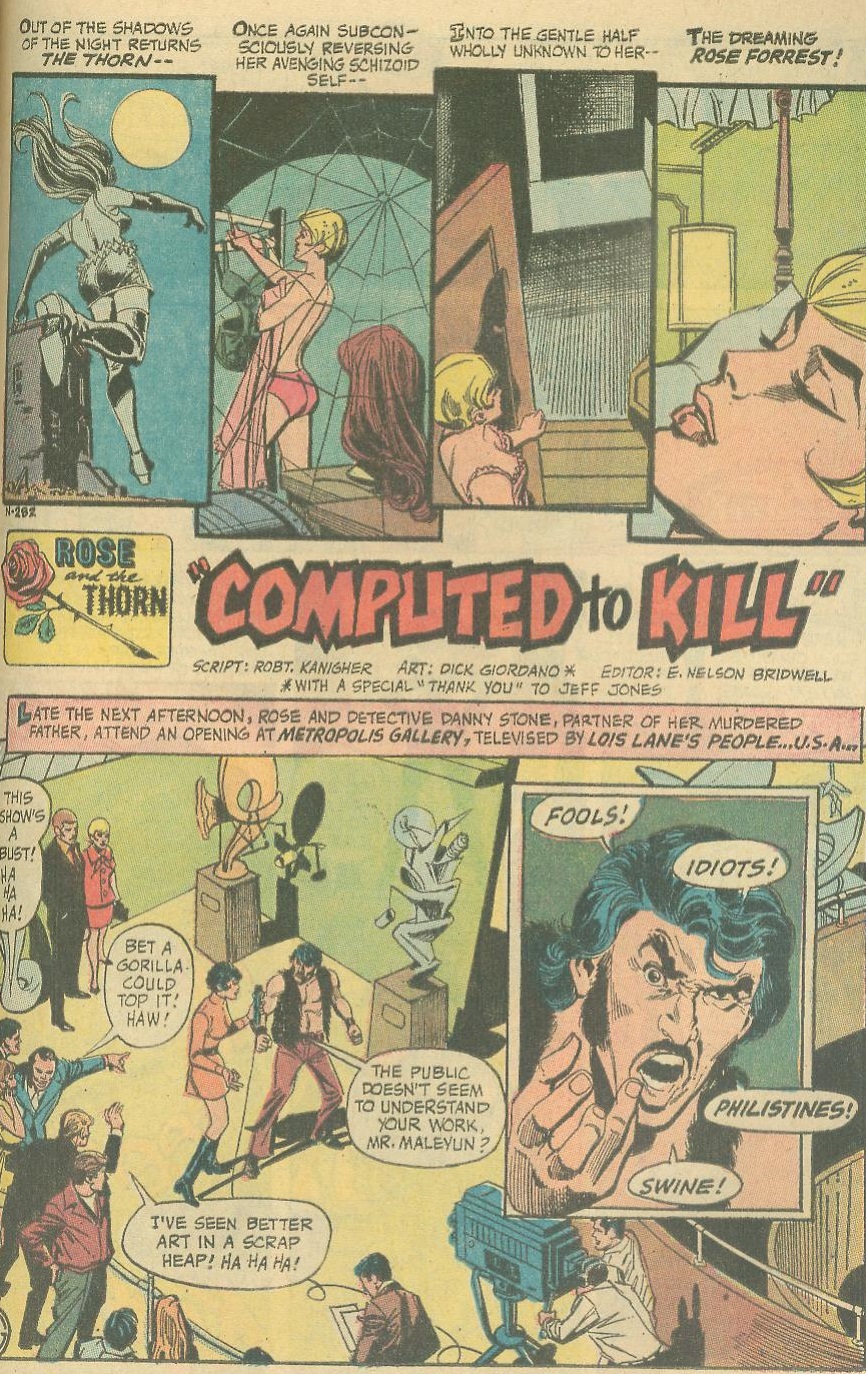

 If any of y’all following along at home can remember way back when we covered the previous part of this story, it ended with the 100 using a stolen Intergang computer, of Apokaliptian tech, to devise a trap for the Nymph of Night. They also brought in Poison Ivy (!) to help put the vigilante on the spot. Well, the device, K.A.R.L., creates a plan involving Mr. Maelyun, a $10,000 sculpture commission, and a $100 an hour modeling fee for the Thorn. It….seems a bit of a stretch as the master plan of a supercomputer, doesn’t it?
If any of y’all following along at home can remember way back when we covered the previous part of this story, it ended with the 100 using a stolen Intergang computer, of Apokaliptian tech, to devise a trap for the Nymph of Night. They also brought in Poison Ivy (!) to help put the vigilante on the spot. Well, the device, K.A.R.L., creates a plan involving Mr. Maelyun, a $10,000 sculpture commission, and a $100 an hour modeling fee for the Thorn. It….seems a bit of a stretch as the master plan of a supercomputer, doesn’t it?
 Once at the studio, the Vixen of Vengeance just blithely trusts this supposed sculptor and allows him to pour a mold over her, which traps her as a living statue. It is then that the 100 spring their trap, with their head man, Vince Adams, showing up to capture his quarry. Oh, and Poison Ivy is there too. For reasons. However, Maelyun suddenly develops a case of Pygmalion madness and has become obsessed with his “creation”, or more accurately, ‘the human being he poured some stuff over.’ Yep, what a genius he is. That’s definitely art that he created. Yep….
Once at the studio, the Vixen of Vengeance just blithely trusts this supposed sculptor and allows him to pour a mold over her, which traps her as a living statue. It is then that the 100 spring their trap, with their head man, Vince Adams, showing up to capture his quarry. Oh, and Poison Ivy is there too. For reasons. However, Maelyun suddenly develops a case of Pygmalion madness and has become obsessed with his “creation”, or more accurately, ‘the human being he poured some stuff over.’ Yep, what a genius he is. That’s definitely art that he created. Yep….










































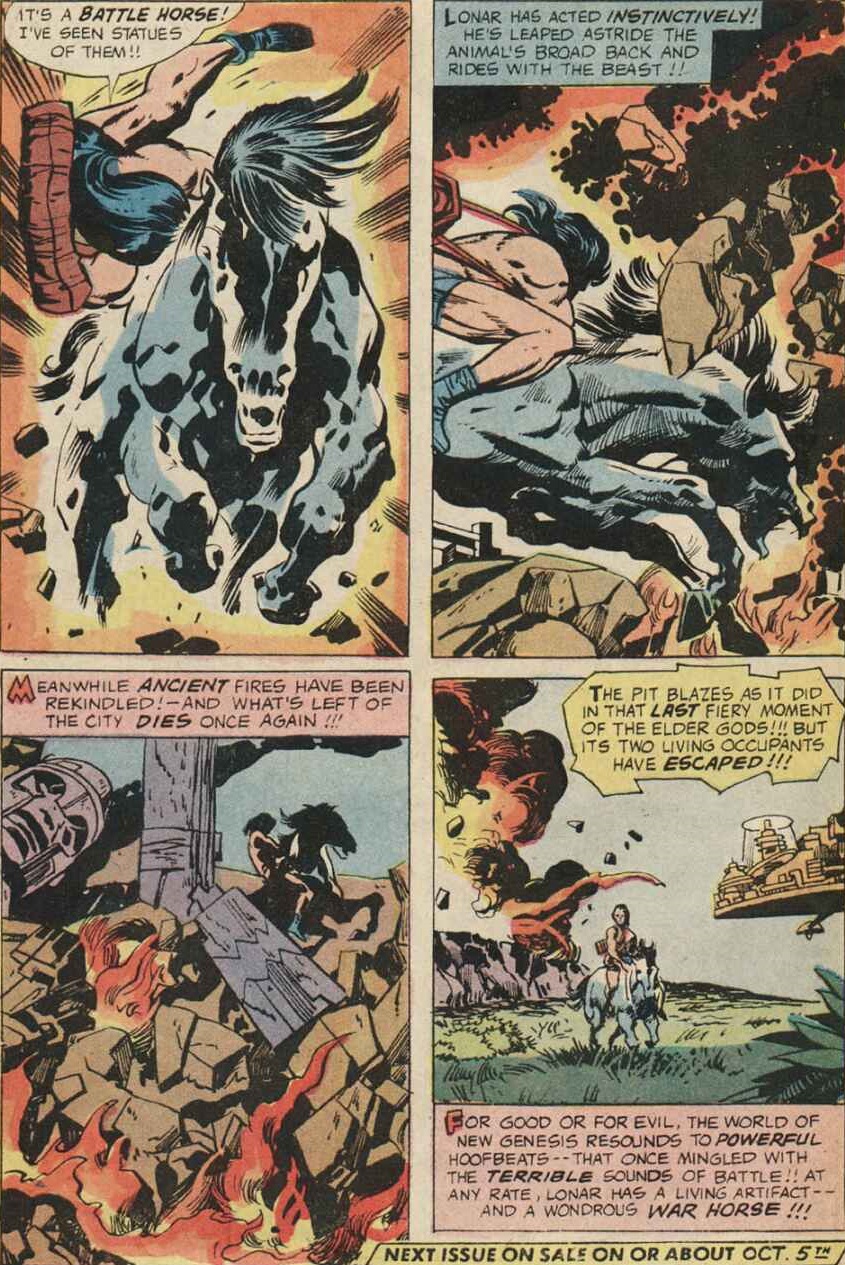



















 That woman happens to be Laura Conway, assistant to Morgan Edge, and the next morning sees her stonewalling Clark Kent and Jimmy Olsen as they try to see her boss and confront him about his shady doings. Things take a turn from the strange when she suddenly goes full vampiress, complete with fangs, pale skin, and missing reflection. She passes out, and before the newsmen can figure out what to do, a bat flies into the office, transforming into our friend the vampire, who helpfully announces that he is “Count Dragorin of Transilvane!” Of course he is.
That woman happens to be Laura Conway, assistant to Morgan Edge, and the next morning sees her stonewalling Clark Kent and Jimmy Olsen as they try to see her boss and confront him about his shady doings. Things take a turn from the strange when she suddenly goes full vampiress, complete with fangs, pale skin, and missing reflection. She passes out, and before the newsmen can figure out what to do, a bat flies into the office, transforming into our friend the vampire, who helpfully announces that he is “Count Dragorin of Transilvane!” Of course he is.




 The Man of Tomorrow saves his beleaguered pal, making short work of the woflman, but he in turn is once more stunned by Dragorin’s eyebeams, allowing the villains to escape. The reporters rally and search the facility, discovering a clue pointing to a cemetery and a “destruct date”, 1971 (incidentally dating this story, which tends to be rare in comics).
The Man of Tomorrow saves his beleaguered pal, making short work of the woflman, but he in turn is once more stunned by Dragorin’s eyebeams, allowing the villains to escape. The reporters rally and search the facility, discovering a clue pointing to a cemetery and a “destruct date”, 1971 (incidentally dating this story, which tends to be rare in comics).





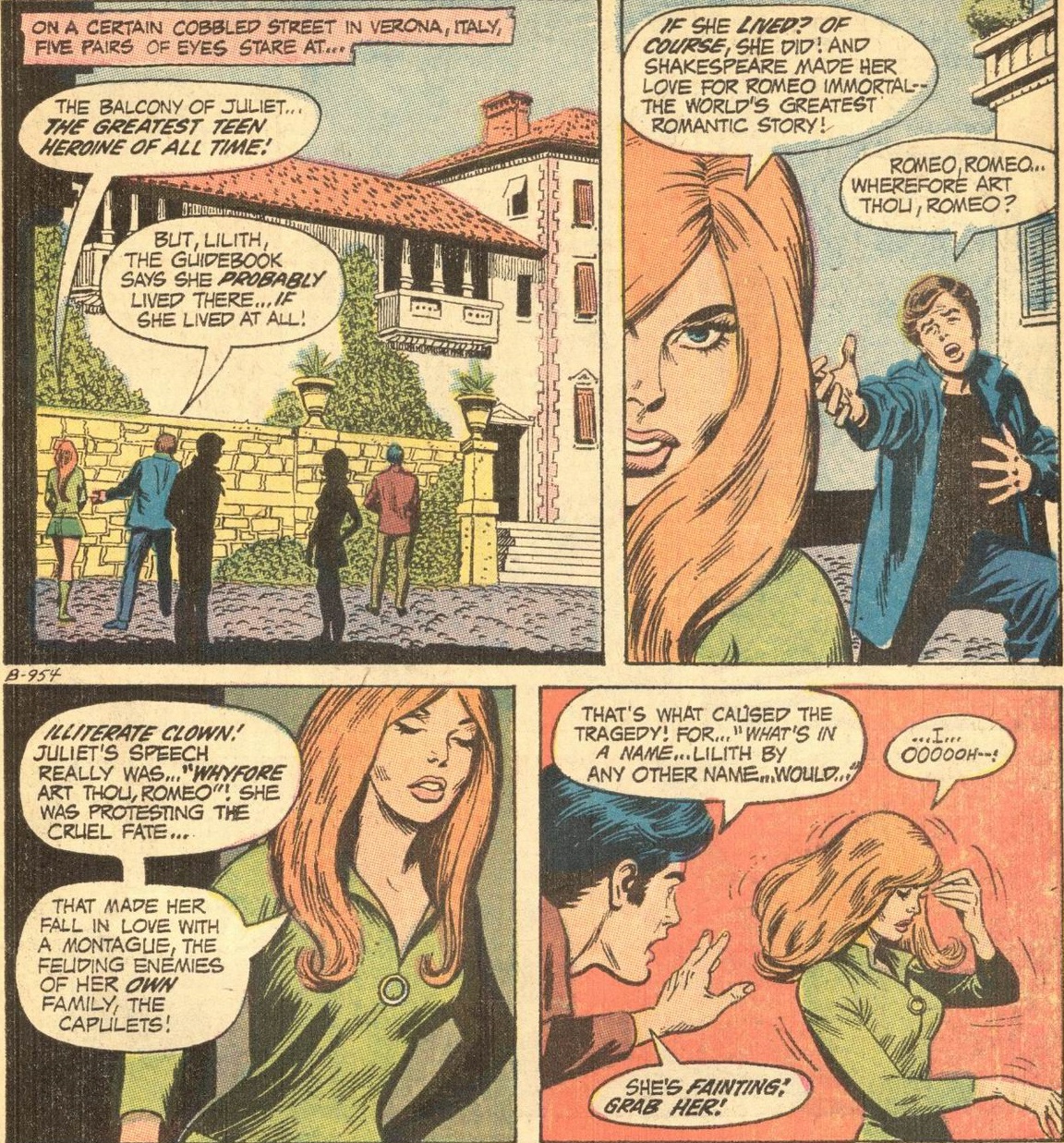
 The story inside begins with Lilith being vague, cryptic, and once more displaying
The story inside begins with Lilith being vague, cryptic, and once more displaying 
 After the intruder leaves, the team heads to a costume ball, just straight-up wearing their costumes, wildly endangering their secret identities. ‘Hey, I wonder if the group of kids traveling with the well known philanthropist could be the same as the superheroes who went to the party with him…’ Nonetheless, at the party, Loggia shows up with his son and nephew, and Lilith immediately falls for the son, reenacting “Romeo and Juliet,” as the kid is the son of her “father’s” enemy. Kid Flash doesn’t take this too well and starts playing the part of Tibalt, starting a brawl with the Loggia family, with the rest of the male Titans joining in until the police show up.
After the intruder leaves, the team heads to a costume ball, just straight-up wearing their costumes, wildly endangering their secret identities. ‘Hey, I wonder if the group of kids traveling with the well known philanthropist could be the same as the superheroes who went to the party with him…’ Nonetheless, at the party, Loggia shows up with his son and nephew, and Lilith immediately falls for the son, reenacting “Romeo and Juliet,” as the kid is the son of her “father’s” enemy. Kid Flash doesn’t take this too well and starts playing the part of Tibalt, starting a brawl with the Loggia family, with the rest of the male Titans joining in until the police show up.








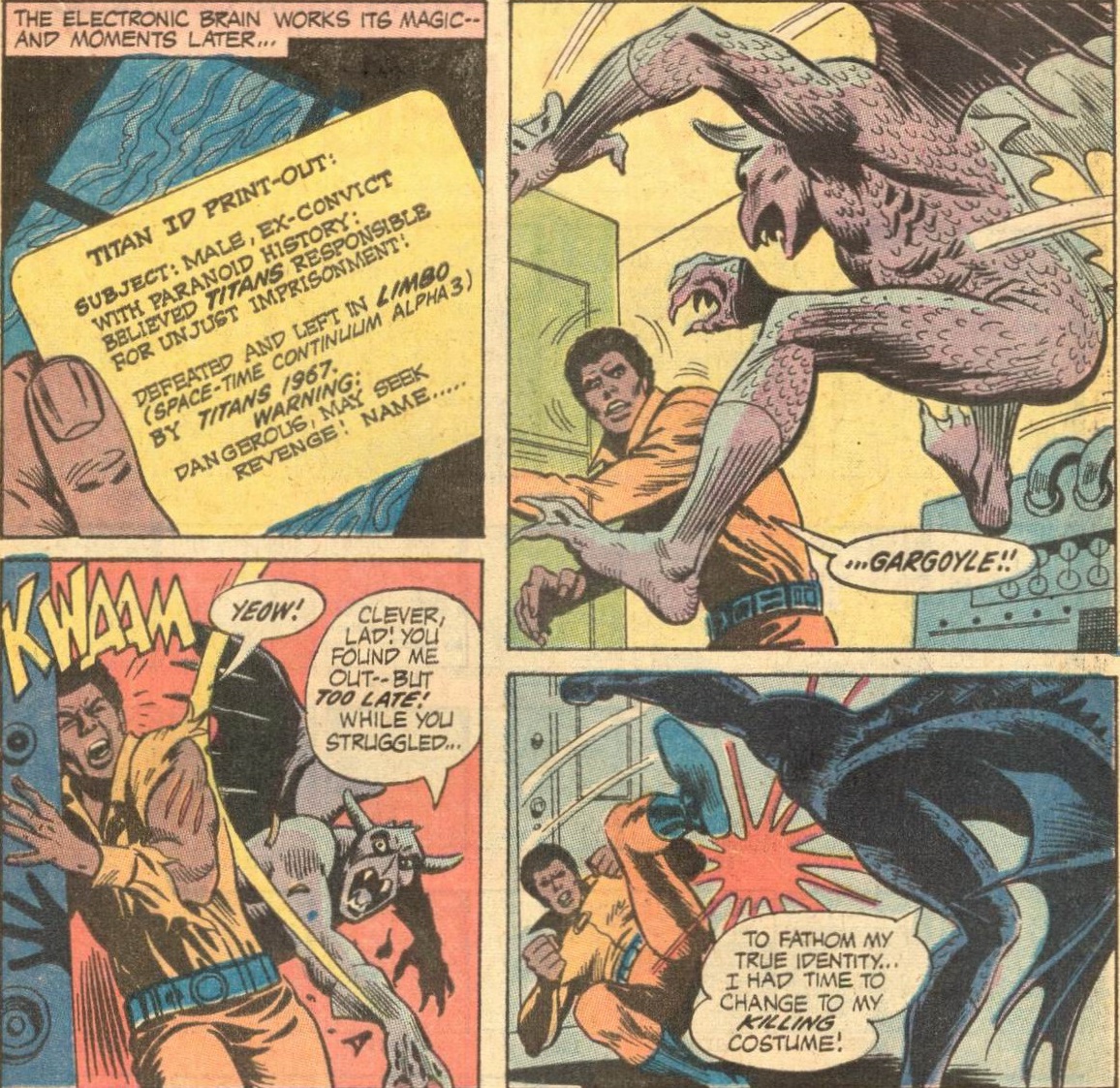
































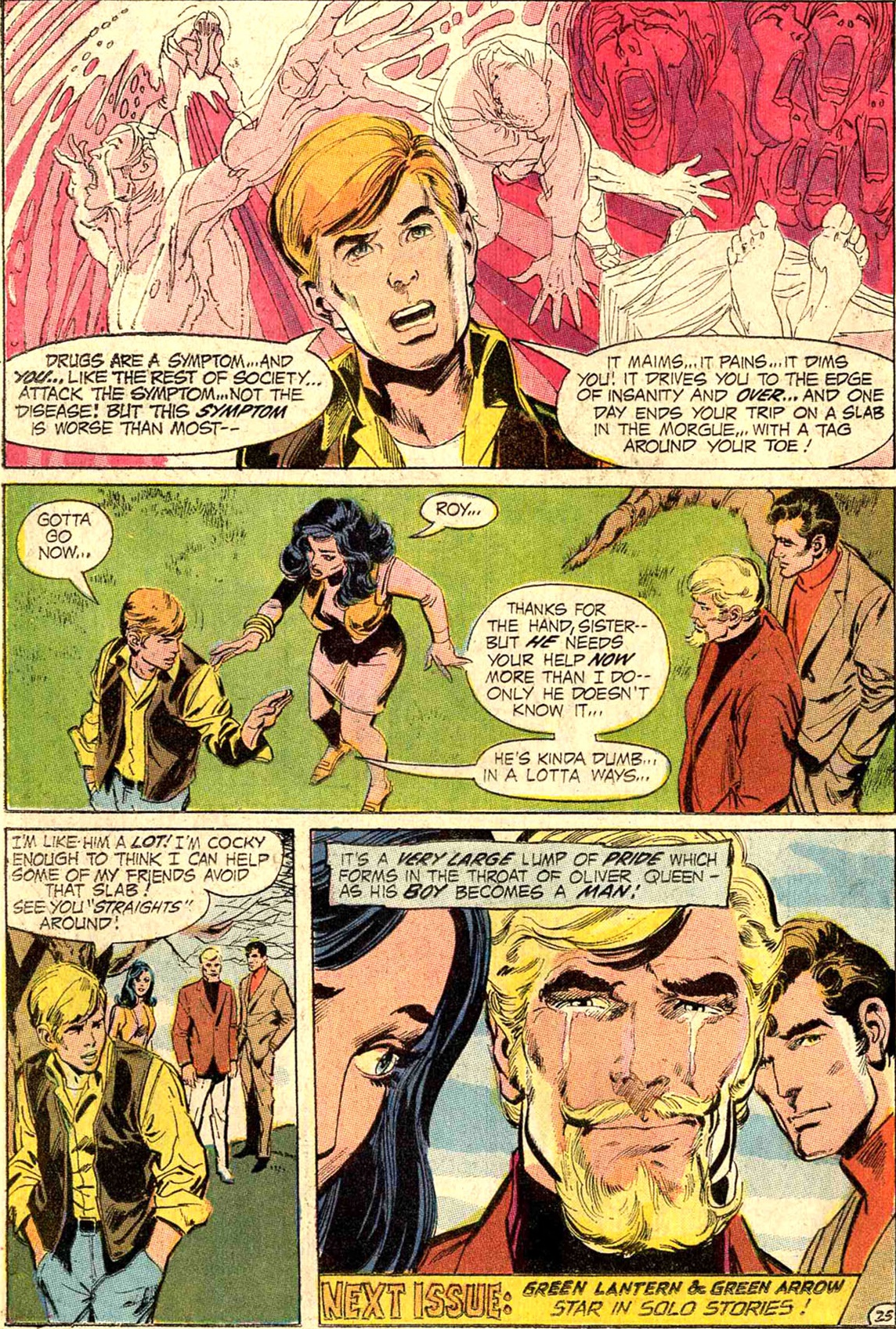






 Suddenly, he’s attacked by refugees from a Robin Hood picture, as a bunch of guys in medieval costumes capture the hero. They drag him into a dungeon, which turns out to be a set in the Galaxy Broadcasting TV studio, conveniently located on this level. Inside is a director, even nuttier than most, who directs his men to kill the interloper so that his death-throes can make for good television! Despite his struggles, Scott is forced into an iron maiden, and all seems lost as the lid slams shut. The whole scene is fun but utterly crazy. It reads like a Fantastic Four issue from the era where Stan and Jack weren’t talking to each other and Stan was thrown into narrative gymnastics in an attempt to explain the bizarre and unrelated images Jack created as his imagination ran away with him. However, this time, there’s nobody to blame for the sudden shift and strange explanation other than Kirby himself. I guess he just wanted to draw an iron maiden, so he shoe-horned the setting in, logic be darned!
Suddenly, he’s attacked by refugees from a Robin Hood picture, as a bunch of guys in medieval costumes capture the hero. They drag him into a dungeon, which turns out to be a set in the Galaxy Broadcasting TV studio, conveniently located on this level. Inside is a director, even nuttier than most, who directs his men to kill the interloper so that his death-throes can make for good television! Despite his struggles, Scott is forced into an iron maiden, and all seems lost as the lid slams shut. The whole scene is fun but utterly crazy. It reads like a Fantastic Four issue from the era where Stan and Jack weren’t talking to each other and Stan was thrown into narrative gymnastics in an attempt to explain the bizarre and unrelated images Jack created as his imagination ran away with him. However, this time, there’s nobody to blame for the sudden shift and strange explanation other than Kirby himself. I guess he just wanted to draw an iron maiden, so he shoe-horned the setting in, logic be darned!


































 In the speed dimension, the Sentinel tells Flash that the strange place is being attacked by a being he calls the Devourer, which is trying to tear its way into the hero’s universe. The being takes a number of random forms, shifting rapidly, including a giant rat, ram, blowtorch, and T-Rex. All of the Scarlet Speedster’s attacks are ineffective, but he finally reasons that, since the normal physical laws don’t apply in this bizarre place, he should try something completely random that would be ineffective in his home dimension.
In the speed dimension, the Sentinel tells Flash that the strange place is being attacked by a being he calls the Devourer, which is trying to tear its way into the hero’s universe. The being takes a number of random forms, shifting rapidly, including a giant rat, ram, blowtorch, and T-Rex. All of the Scarlet Speedster’s attacks are ineffective, but he finally reasons that, since the normal physical laws don’t apply in this bizarre place, he should try something completely random that would be ineffective in his home dimension.



 In a fun bit of detail, he notes that when he started out he expected to be stumbling over heists all the time, but unlike in “comic mags,” such things have proven rare. Yet, when he goes to eject his costume from his ring, a strange gas emerges instead, knocking him out!
In a fun bit of detail, he notes that when he started out he expected to be stumbling over heists all the time, but unlike in “comic mags,” such things have proven rare. Yet, when he goes to eject his costume from his ring, a strange gas emerges instead, knocking him out!












 Then Kirby’s inimitable imagination is on strange and unsettling display as he takes us on a tour of the torments Desaad has devised for our young heroes. First, Mark Moonrider is locked in another glass prison, this one rendering him as an animated skeleton to the people passing below. Big Bear, for his part, is in a shooting gallery where the park-goers see him as a robotic bear, and their each shot creates a cacophony of sonic chaos within his cell. Beautiful Dreamer has a more sedate torture in store for her, as the uber-creepy master masochist paralyzes her and inserts her into a glass coffin, where the illusion works in the opposite way of the others, rendering the harmless civilians who regard her as hideous monsters waiting to devour the helpless damsel.
Then Kirby’s inimitable imagination is on strange and unsettling display as he takes us on a tour of the torments Desaad has devised for our young heroes. First, Mark Moonrider is locked in another glass prison, this one rendering him as an animated skeleton to the people passing below. Big Bear, for his part, is in a shooting gallery where the park-goers see him as a robotic bear, and their each shot creates a cacophony of sonic chaos within his cell. Beautiful Dreamer has a more sedate torture in store for her, as the uber-creepy master masochist paralyzes her and inserts her into a glass coffin, where the illusion works in the opposite way of the others, rendering the harmless civilians who regard her as hideous monsters waiting to devour the helpless damsel.
























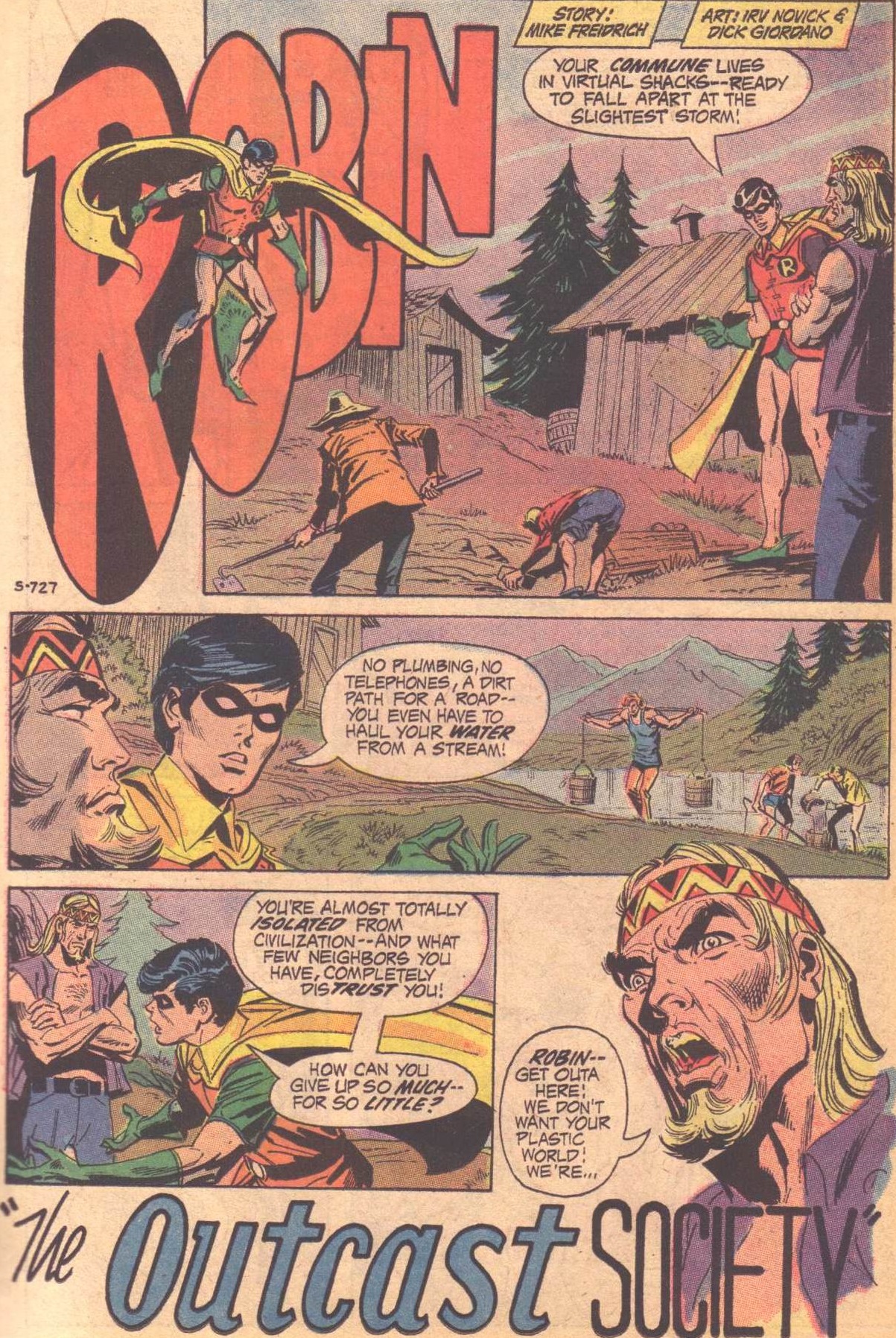










 Years later, when Luis’s father began to search for a lost cultural treasure of Mexico, an idol of the ‘smiling god,’ Choclotan (which is, of course, fictional), the old champ came to help. Yet, when the pair were searching the mountains for the lost treasure, Luis’s father was killed and Ted’s head was creased by a bullet, leaving him amnesiac. Apparently there is a sinister band of smugglers after the treasure as well, headed by a shadowy figure known as El Grande. They are the ones behind the attacks on the duo.
Years later, when Luis’s father began to search for a lost cultural treasure of Mexico, an idol of the ‘smiling god,’ Choclotan (which is, of course, fictional), the old champ came to help. Yet, when the pair were searching the mountains for the lost treasure, Luis’s father was killed and Ted’s head was creased by a bullet, leaving him amnesiac. Apparently there is a sinister band of smugglers after the treasure as well, headed by a shadowy figure known as El Grande. They are the ones behind the attacks on the duo. Luis found his costume and has been helping him make a living by fighting as ‘El Tigre,’ while the youth cliff-dived for tourists. Yep, sounds like a great plan. Have the man with brain damage fight in boxing matches! Anyway, poor judgement aside, Batman agrees to help, and they set out to search for Choclotan. They encounter an old friend of Luis’s family on the way, a rancher named El Sordo, who owns a massive stead in they area they are traveling. Apparently he was Luis’s father’s manager, and he offers to guide the group in their search.
Luis found his costume and has been helping him make a living by fighting as ‘El Tigre,’ while the youth cliff-dived for tourists. Yep, sounds like a great plan. Have the man with brain damage fight in boxing matches! Anyway, poor judgement aside, Batman agrees to help, and they set out to search for Choclotan. They encounter an old friend of Luis’s family on the way, a rancher named El Sordo, who owns a massive stead in they area they are traveling. Apparently he was Luis’s father’s manager, and he offers to guide the group in their search.








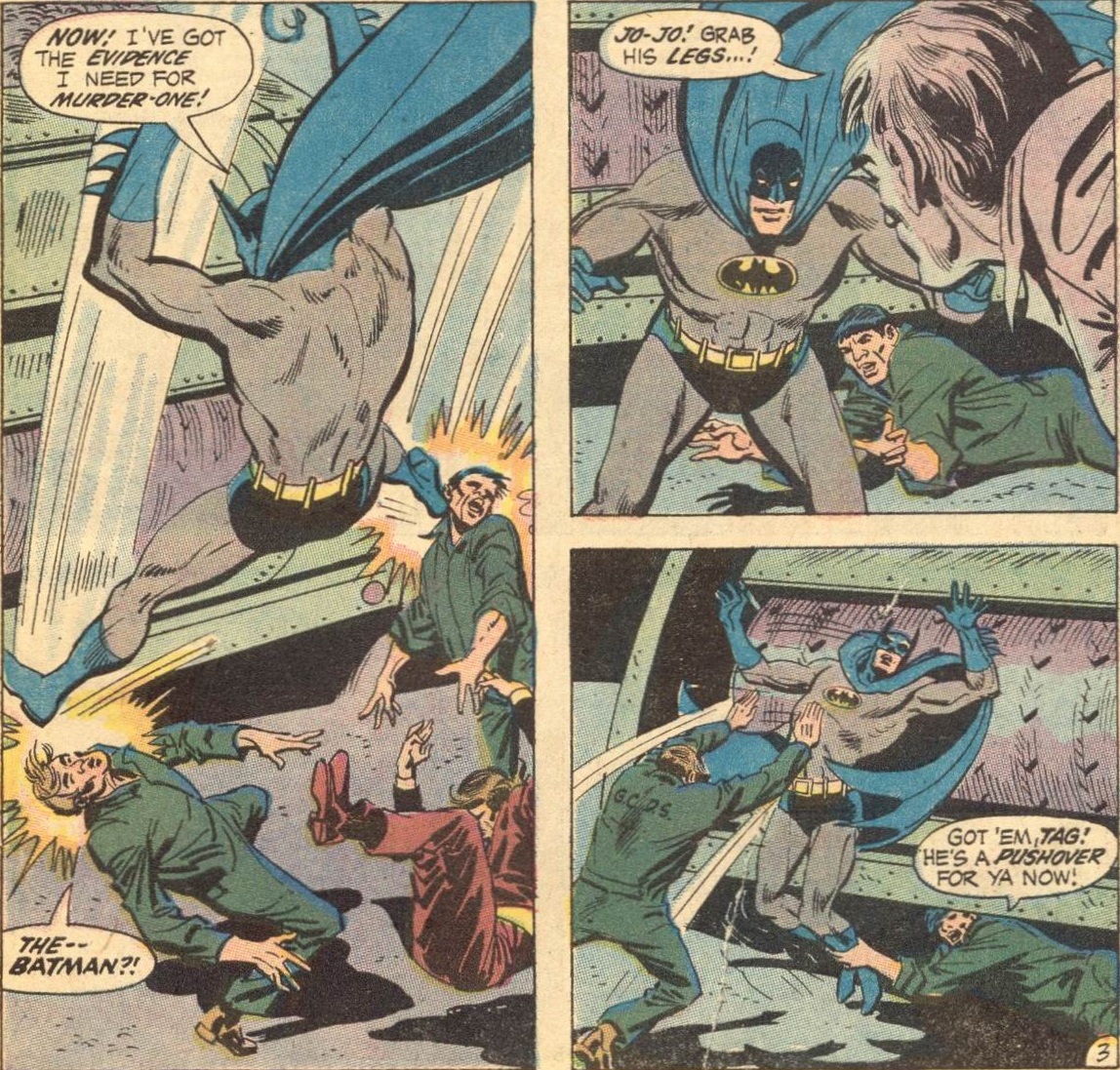
 Anyway, this pseudo-Nader, Tom Carson, tells Batman that he has a lot of enemies because of all of the big companies he’s ticked off by exposing their malfeasance. Yet, the most recent case is Magna Industries, who were preparing to introduce a “microwave anti-pollution device.” Carson’s group was testing their product, and he notes that a poor result could be disastrous for the company. The Caped Crusader drops Carson off with Barbara Gordon for safekeeping, which is a fun little detail, and then he heads to check out Ben Ames, president of the company in question. He notes that, as Bruce Wayne, he knows Ames personally, and can’t believe he’s behind the hit.
Anyway, this pseudo-Nader, Tom Carson, tells Batman that he has a lot of enemies because of all of the big companies he’s ticked off by exposing their malfeasance. Yet, the most recent case is Magna Industries, who were preparing to introduce a “microwave anti-pollution device.” Carson’s group was testing their product, and he notes that a poor result could be disastrous for the company. The Caped Crusader drops Carson off with Barbara Gordon for safekeeping, which is a fun little detail, and then he heads to check out Ben Ames, president of the company in question. He notes that, as Bruce Wayne, he knows Ames personally, and can’t believe he’s behind the hit. At the Ames estate, the Dark Knight sees a light on and reasons that the corporate bigwig might be waiting for a certain call. Disguising his voice, Batman fakes the call from the Carson’s car, which he borrowed, and proves Ames’ guilt. In order to figure out his motive, the hero tries a more theatrical approach. He uses some of Carson’s spare clothes and some phosphorescent paint to stage a ghostly visitation. Suddenly, Ames is confronted by the “ghost” of the man he tried to have killed! During the confrontation, Ames declares that Carson drove him to it because he tried to blackmail his company, threatening to release a damning report, despite the fact that the device was perfectly safe.
At the Ames estate, the Dark Knight sees a light on and reasons that the corporate bigwig might be waiting for a certain call. Disguising his voice, Batman fakes the call from the Carson’s car, which he borrowed, and proves Ames’ guilt. In order to figure out his motive, the hero tries a more theatrical approach. He uses some of Carson’s spare clothes and some phosphorescent paint to stage a ghostly visitation. Suddenly, Ames is confronted by the “ghost” of the man he tried to have killed! During the confrontation, Ames declares that Carson drove him to it because he tried to blackmail his company, threatening to release a damning report, despite the fact that the device was perfectly safe.






 Our Batgirl backup picks up
Our Batgirl backup picks up 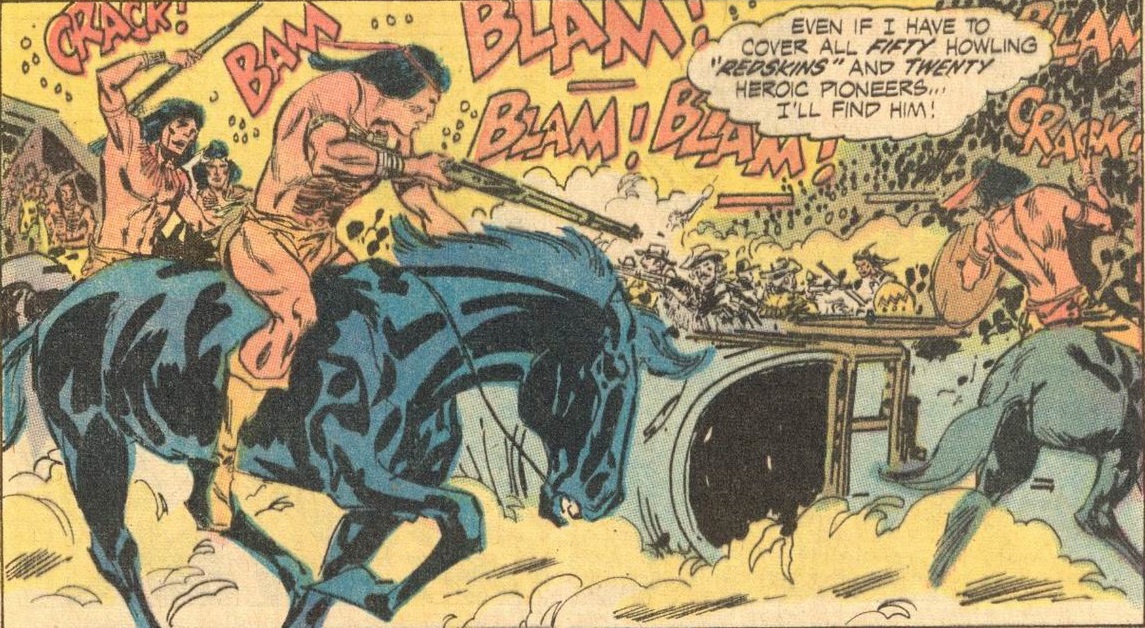

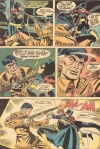



















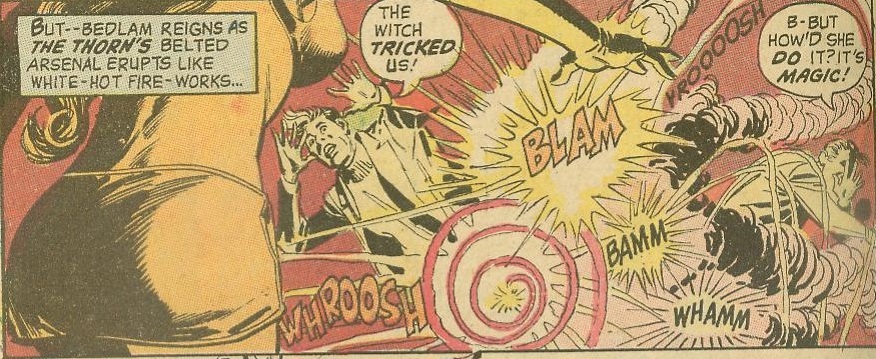





















 Smarting from their defeat, the punks decide that they must have revenge, and one of them draws a gun. Unaware they’re being chased, the couple stop by a radio studio, which is supposed to be the first part of their date (which seems like a weird choice), but when they open the elevator doors, they find, not the office they expected, but a bleak, blasted landscape! Suddenly, the not so wondrous woman is unable to breathe, and the Man of Steel realizes that there is very little oxygen in the atmosphere. At super speed, he finds a pocket of air underground and carries his date to safety. Building her a shelter, the Kryptonain, who doesn’t need air, sets out to see what is going on here.
Smarting from their defeat, the punks decide that they must have revenge, and one of them draws a gun. Unaware they’re being chased, the couple stop by a radio studio, which is supposed to be the first part of their date (which seems like a weird choice), but when they open the elevator doors, they find, not the office they expected, but a bleak, blasted landscape! Suddenly, the not so wondrous woman is unable to breathe, and the Man of Steel realizes that there is very little oxygen in the atmosphere. At super speed, he finds a pocket of air underground and carries his date to safety. Building her a shelter, the Kryptonain, who doesn’t need air, sets out to see what is going on here.


 Finding a bizarre, golden tower, the only sign of life on this desolate world, he charges in, smashing past defenses, only to find himself face to circuit with a robot, built into the structure itself. The machine explains that this is the future of the Earth, 2171, one hundred years in his future. Apparently, an event in Superman’s time lead to the destruction he has observed in this future. Notably, the android explains that this is just a possible future, and one which might be prevented if the catalyst event is altered. Realizing this, the mechanical man developed time travel capacity (how convenient!), allowing it to bring forward agents that could affect such change. To that end, it was the machine that manipulated events in the past to bring the two heroes together, which just seems unnecessarily complicated. It then shows Superman a clip of the defining moment, a college protest which turns into a riot, during which someone will be killed, someone who, otherwise, would prevent this future.
Finding a bizarre, golden tower, the only sign of life on this desolate world, he charges in, smashing past defenses, only to find himself face to circuit with a robot, built into the structure itself. The machine explains that this is the future of the Earth, 2171, one hundred years in his future. Apparently, an event in Superman’s time lead to the destruction he has observed in this future. Notably, the android explains that this is just a possible future, and one which might be prevented if the catalyst event is altered. Realizing this, the mechanical man developed time travel capacity (how convenient!), allowing it to bring forward agents that could affect such change. To that end, it was the machine that manipulated events in the past to bring the two heroes together, which just seems unnecessarily complicated. It then shows Superman a clip of the defining moment, a college protest which turns into a riot, during which someone will be killed, someone who, otherwise, would prevent this future.



 After rescuing the former Wonder Woman, the Man of Tomorrow heads back to the robot’s citadel, only to find it running out of energy. Gathering the other three unwilling time travelers, Superman desperately races to get back through the time rift before it closes, just barely making it. Grabbing Diana, he races off once again to reach the site of the destined riot, and the two split up to try and calm things down. Their efforts are for naught, though, as one of the hot-headed students throws a Molotov cocktail, blowing up a car, and the guards open fire. In the aftermath, Diana finds a kid safe and sound who matches the description of the future-bot, only for Superman to discover a dead guard who also could be the one. Desperately, the heroine asks her partner which one is their target, only for him to respond hopelessly that they’ll never know until it’s too late!
After rescuing the former Wonder Woman, the Man of Tomorrow heads back to the robot’s citadel, only to find it running out of energy. Gathering the other three unwilling time travelers, Superman desperately races to get back through the time rift before it closes, just barely making it. Grabbing Diana, he races off once again to reach the site of the destined riot, and the two split up to try and calm things down. Their efforts are for naught, though, as one of the hot-headed students throws a Molotov cocktail, blowing up a car, and the guards open fire. In the aftermath, Diana finds a kid safe and sound who matches the description of the future-bot, only for Superman to discover a dead guard who also could be the one. Desperately, the heroine asks her partner which one is their target, only for him to respond hopelessly that they’ll never know until it’s too late!


